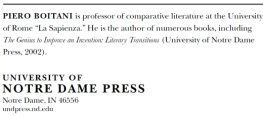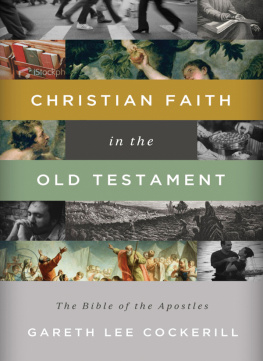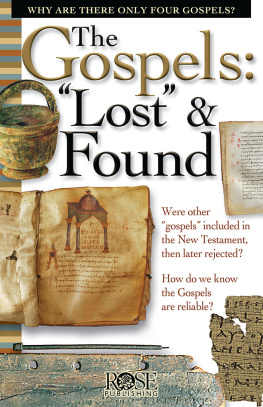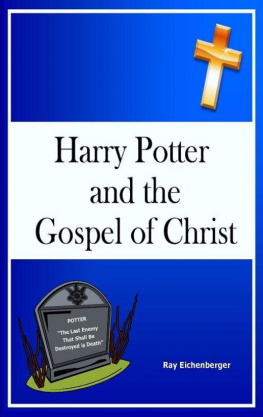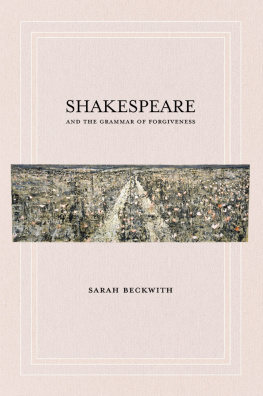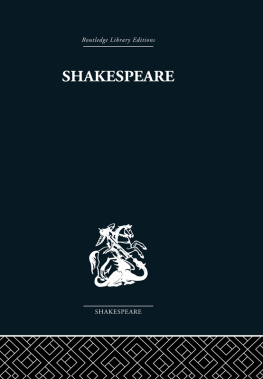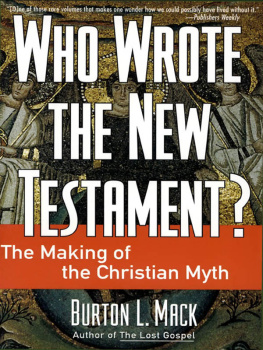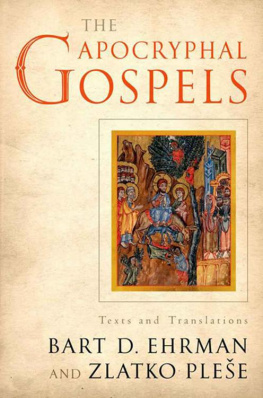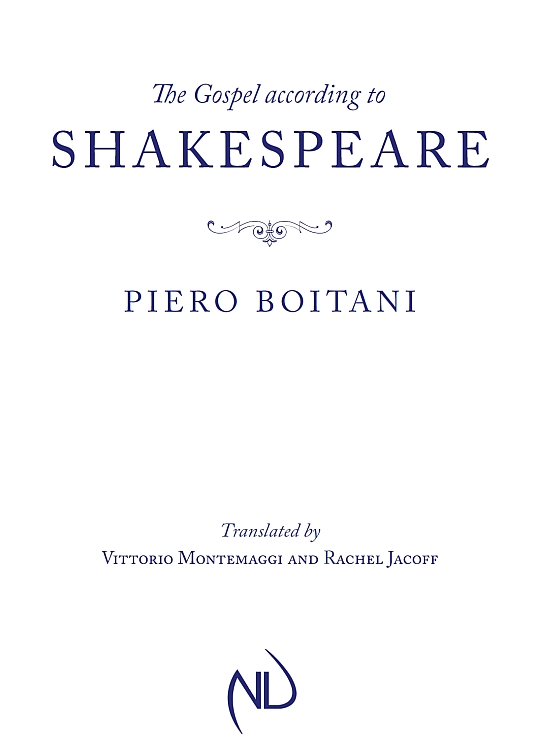
The Gospel according to
SHAKESPEARE
PIERO BOITANI
Translated by
V ITTORIO M ONTEMAGGI AND R ACHEL J ACOFF
University of Notre Dame Press
Notre Dame, Indiana
Copyright 2013 by University of Notre Dame
Notre Dame, Indiana 46556
All Rights Reserved
E-ISBN 978-0-268-07568-2
This e-Book was converted from the original source file by a third-party vendor. Readers who notice any formatting, textual, or readability issues are encouraged to contact the publisher at
To
G ORDON T ESKEY
and the memory of
F RANK K ERMODE
Contents
Shakespeares plays are quoted from the Arden editions, as follows: Hamlet, ed. H. Jenkins (1982); King Lear, ed. K. Muir (1952) and ed. R.A. Foakes (1997); Pericles, ed. F. D. Hoeniger (1963); Cymbeline, ed. J.M. Nosworthy (1955); The Winters Tale, ed. J.H. P. Pafford (1963); and The Tempest, ed. F. Kermode (1954). All these editions have excellent commentaries. Other editions are listed in the selected bibliography. Other plays are quoted from The Oxford Shakespeare, 2nd ed., ed. S. Wells, G. Taylor, J. Jowett, and W. Montgomery (Oxford: Clarendon Press, 2005). The Bible is quoted from the King James version or the New Revised Standard Version, unless stated otherwise. References to Greek and Latin texts are to the Loeb edition.
For several years I had been thinking of writing a small book with a title like the present one and had indeed written various pieces that dealt with these themes. Confronting Shakespeare, and his last plays in particular, is almost impossible, and to couple him with the Gospels and with the whole of Scripture is definitely foolhardy. Yet they are challenges one can hardly resist, because the texts involved are among the masterpieces of world literature, and the prospect of saying something new about them is indeed irresistible to a critic, especially to one who, like myself, has dealt with similar canonical textsthe Bible and its rewritings, the Odyssey and its reincarnations, Danteand who intended to write a book not only for scholars but also for students and the general public.
This aim had two consequences for the shape the book was to take, one in the plot and one in the method. I started with the plot, being convinced that, from the second section of Hamlet onwards, Shakespeare is engaged in developing his own Gospel. Thus, I arranged the plays in a roughly chronological sequence that would constitute my general plot: from Hamlet to King Lear, where Shakespeares New Testament is only announced and where faith, salvation, and peace are only glimpsed at from far away, and on to Pericles,Cymbeline,The Winters Tale, and The Tempest, where the themes of transcendence, immanence, the role of the deity, resurrection, and epiphany are openly, if often obliquely, staged. The Christian Gospels and the Christian Bible represent the signposts, as it were, of this itinerary. Hamlets new attitude to life and death after his return from England is signaled by his There is special providence in the fall of a sparrow, a quotation from Matthew. Lear seems to go one step further when he tells Cordelia that they will pray, and sing, and tell old tales, and take upon [themselves] the mystery of things as if they were Gods spies. The old tales are in fact the romances, from Pericles to The Tempest, which Shakespeare will produce in the next few years. All of them, like King Lear, will involve a father and a daughter figure; all, like King Lear, will stage amazing recognition scenes. More of this in the introduction.
My second problem was the way in which I would narrate this plot. It was clear to me, from experiences in classrooms all over the world (England, the United States, and other English-speaking countries included), and from the lectures I had been giving to general audiences, even in public venues and on television, that todays public does not know Shakespeares plays as well as it did two or three generations ago. One needs, in the first place, to tell the stories, which are by themselves capable of producing endless wondertell the stories in detail, because the devil, or God, is hidden in the details. Plot, as Aristotle himself saw (he called it mythos), is what gets an audience at a performance. Plot is what keeps up the suspense and eventually produces catharsis, final pain, joy, elation, revelation. Arranging the plot is the supreme trick of the artist and, I think, of todays critic. If you tell a story well while teaching Homer, Dante, Tolstoy, or Conrad, you already are half of the way with your audience.
Only half of the way, however. The other half is to make your theme, and your argument, emerge from the plot and from the verbal texture of a play or a novel, letting the author speak as much as possiblewhich obviously needs no justification with the likes of Shakespeare, who terrifies and enchants simply by having his characters pronounce certain words in a certain order. By pointing out the recurrence of themes, images, allusions, one then weaves into the text what would seem to be a running commentary but is in fact a kind of continuous meditation. For what, after the plot, draws the critics attention to these particular works is the mystery they conceal at some key points; and the critic, as well as the audience, wants to know more about itwants, in fact, to think about it and discover its secret. A string of enigmas will produce thoughtfulness, reflection, further reading into the text, and the need to establish comparisons.
At times, the puzzle need only be indicated to stay in the readers mind (and heart) and eventually trigger enlightenment. At the very beginning of The Tempest, for instance, Ariel tells Prospero that, apart from Ferdinand, and on the other side the sailors, all the other shipwrecked human beings on the island (the King of Naples, the Duke of Milan, and their courtiers) are in the deep nook, where once / Thou calldst me up at midnight to fetch dew / From the still-vexd Bermoothes. This is a sudden, non-required excess (there is no logical need for this information) as well as an absolutely wonderful leap of the imagination. Why the Bermudas? And why should Prospero have evoked Ariel to fetch dew, of all things, at midnight? One should enjoy or even feel immense surprise and elation at the use of such an image, then store it somewhere in ones memory, slowly begin to realize that the Bermudas and the New World will construct the other face of The Tempests Mediterranean island, and just as slowly unravel the mystery of Ariels calling and his final song of freedom (Where the bee sucks).
In short, this book has little in common with contemporary Shakespeare criticism. I would like it to be rather like a classroom step-by-step lectura, somewhere between the medieval or Renaissance commentary and the modern essay, with my introduction and conclusion providing the framework for the stories within by presenting and summing up the general plot. It is, above all, a narration, which, like music (there is so much music in Shakespeares last plays), picks up and returns to the motifs of living, generating, dying, and being reborn that form the substance of the unique Gospel according to William Shakespeare.
T HE A MERICAN EDITION of this book would not have been possible without the efforts of Vittorio Montemaggi and Rachel Jacoff, who have collaborated in translating it. An earlier version of chapter 3, by Anita Weston, then revised by Noeleen Hargan, has also been used. However, the impulse to produce a translation that would make the volume available to an English-speaking audience first came from Frank Kermode and Gordon Teskey, to both of whom it is therefore dedicated. As with the Italian edition, Nadia Fusini has been a constant and inspiring friend, and the
Next page
